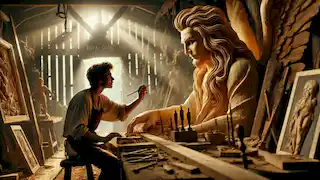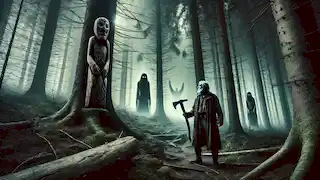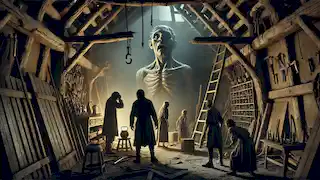In the heart of the Black Forest lies the village of Schwartzenfeld, a quaint hamlet enveloped in the misty embrace of tall pines and hidden trails. Though picturesque and serene, this village holds a chilling tale passed down through countless generations: the story of the Odel. This tale is a mixture of folklore, warning, and mystery, weaving together the fates of a family, a forest, and the spirits that bind them. To this day, the legend lingers, haunting the imaginations of all who hear it. Centuries ago, Schwartzenfeld was little more than a collection of small cottages surrounded by wilderness. The villagers lived simple lives, hunting, gathering, and relying on each other to endure the unforgiving winters. On the edge of the forest stood the Odel family home, a modest timber structure adorned with intricate carvings. The Odels were woodworkers, but their creations were unlike any others in the region. Each piece they made seemed imbued with life, their designs so intricate that they seemed almost magical. The patriarch, Mathias Odel, was a quiet man, his weathered hands skilled in carving even the most delicate patterns. His wife, Alina, was equally adept at finishing the pieces, painting and varnishing them with a perfection that seemed supernatural. Together, they had two sons: Lukas, the younger and more restless of the two, and Johan, who took after his father with his reserved and contemplative demeanor. Though the family was admired for their craft, they kept to themselves, rarely attending village gatherings. Rumors swirled about the source of their talent. Some believed it was divine, while others whispered that they had made a pact with the spirits of the forest. For generations, the Odel family honored their unspoken connection to the woods, taking only what they needed and leaving offerings of carved totems among the trees. In return, the forest provided for them, and their talents flourished. Lukas Odel was a dreamer. Unlike his family, who found contentment in their quiet lives, Lukas yearned for recognition and wealth beyond Schwartzenfeld. He would sit for hours by the fire, sketching elaborate designs that he hoped would one day bring him fame. His favorite sketch was a towering sculpture of an ancient forest guardian, a mythical creature he envisioned as a protector of the woods. One day, while exploring the village market, Lukas overheard a traveling merchant speaking of distant cities where art was celebrated and revered. The merchant’s words ignited a fire within Lukas. He decided that his destiny lay beyond the confines of Schwartzenfeld, even if it meant defying his family’s traditions. Against his father’s stern warnings, Lukas poured all his energy into carving his masterpiece: the forest guardian. The sculpture was enormous, its features both fierce and majestic. Every detail, from the texture of its bark-like skin to the piercing intensity of its wooden eyes, reflected Lukas’s ambition. When it was finished, it seemed almost alive. Ignoring his father’s protests, Lukas sold the sculpture to the traveling merchant for a hefty sum. He dreamed of the acclaim it would bring him, but as the sculpture was carted away, a strange unease settled over the village. That night, the wind howled through the trees, and the forest seemed darker than ever before. In the days that followed, the villagers noticed unsettling changes. The crops began to wither, animals grew restless, and an unnatural silence fell over the forest. Those who ventured into the woods spoke of feeling watched, and some claimed to hear faint whispers carried on the wind. The Odels, once respected for their craftsmanship, became the focus of the villagers’ fear and suspicion. Mathias, realizing that the family’s pact with the forest had been broken, decided to act. He ventured deep into the woods, carrying only his tools and a small offering of carved totems. His intention was to seek forgiveness from the forest spirits and restore the balance that Lukas had disrupted. But Mathias never returned. Days turned to weeks, and the forest remained as foreboding as ever. The villagers, desperate for answers, demanded that the remaining Odels fix what had been broken. Lukas, consumed by guilt, locked himself in his workshop, determined to undo the damage. Yet, no matter how many carvings he made, the forest’s anger did not subside. His creations, once beautiful and serene, now seemed distorted and anguished, as though reflecting the turmoil within him. One stormy night, a terrible wailing echoed from Lukas’s workshop. The villagers, too afraid to investigate, waited until morning to see what had happened. When dawn arrived, the workshop was empty. Lukas had vanished, leaving behind only his tools and his latest carving—a grotesque figure that seemed to writhe in agony despite being made of wood. Rumors spread that Lukas had been claimed by the forest, punished for his hubris. Some said they saw ghostly figures in the woods, their forms resembling Lukas and his family. The villagers, now deeply fearful of the Odels’ legacy, avoided the forest whenever possible. Years turned into decades, and the tale of the Odels became a legend. Yet, strange occurrences persisted. Carvings bearing the unmistakable style of the Odel family would appear in the forest, often in places where travelers had gone missing or where the forest seemed especially dense and impenetrable. These carvings, though exquisitely detailed, exuded an eerie presence. Some believed they were warnings, while others thought they were guardians left by the forest spirits to protect the woods from further harm. The villagers spoke of the “Odel Curse,” a belief that anyone who disrespected the forest would face the wrath of the carvings. Hunters who took more than they needed or loggers who cut down too many trees often found themselves lost in the woods, their paths twisting and turning endlessly until they stumbled upon an Odel carving. The figures seemed to watch them, their wooden eyes filled with sorrowful reproach. Decades later, a wandering artist named Clara arrived in Schwartzenfeld. Fascinated by the legend of the Odels, she decided to explore the forest and document her findings. Armed with a sketchbook and an unshakable curiosity, Clara ventured into the woods, determined to uncover the truth. Clara’s sketches and journals captured the haunting beauty of the Odel carvings. Each piece seemed more lifelike than the last, their expressions a mix of anguish and quiet dignity. Her entries described strange phenomena: the feeling of being watched, the sound of footsteps when no one was there, and the sense that the forest itself was alive. In her final entry, Clara wrote of discovering a hidden clearing deep within the forest. The clearing was filled with Odel carvings, arranged in a circle around a single figure—a life-sized sculpture of a young man. The figure’s face bore an uncanny resemblance to the descriptions of Lukas Odel. Clara wrote that the carvings seemed to whisper as she approached, their voices a mournful lament. But before she could document more, her journals ended abruptly. Neither Clara nor her belongings were ever found. To this day, the legend of the Odel remains a part of Schwartzenfeld’s identity. Some villagers see it as a cautionary tale about the dangers of ambition and greed, while others believe it is a testament to the enduring bond between humanity and nature. The forest, still dense and mysterious, stands as a living reminder of the story. Travelers who hear the tale often find themselves drawn to the Black Forest, hoping to catch a glimpse of the fabled Odel carvings. Some return with stories of eerie encounters, while others are never seen again. The villagers, though wary of outsiders, continue to share the legend, ensuring that the memory of the Odels lives on.The Odel Family
Lukas’s Ambition
The Pact Broken

Lukas’s Descent
The Legacy of the Odels

The Wanderer’s Tale

The Odel Today

The Story of the Odel
Reading Time: 7 min

About Story: The Story of the Odel is a Legend Stories from germany set in the Medieval Stories. This Dramatic Stories tale explores themes of Nature Stories and is suitable for Adults Stories. It offers Moral Stories insights. A haunting tale of ambition, art, and the unyielding power of nature.


















